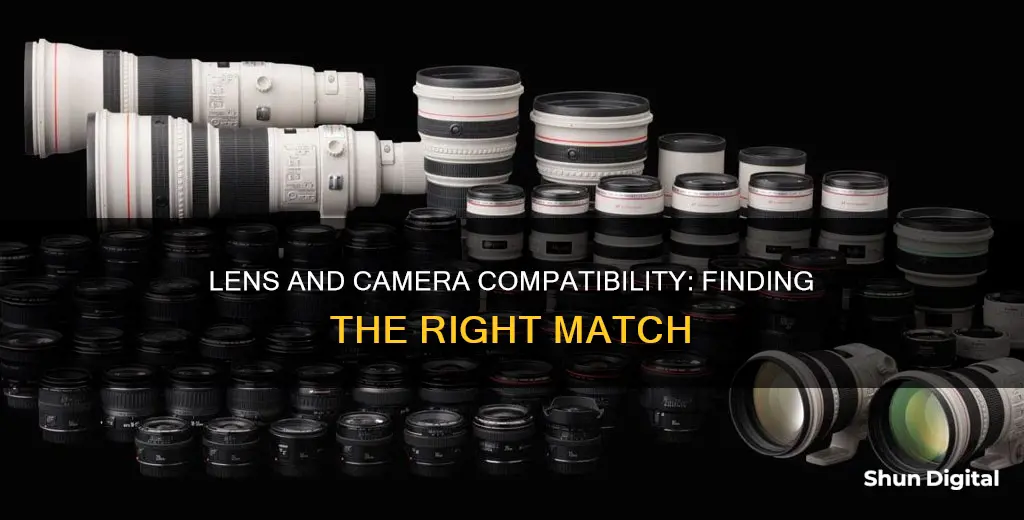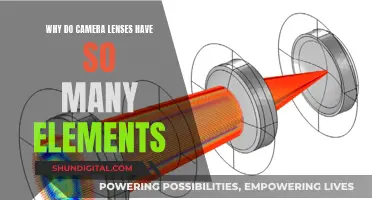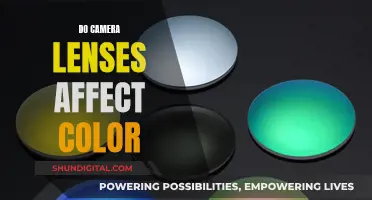
When it comes to photography, choosing the right lens for your camera is essential. Various factors determine lens compatibility, and it's important to understand the different types of lenses and camera systems to ensure the best results. This guide will explore the world of lens and camera compatibility, helping you navigate the complex landscape of lens mounts, camera sensors, and the unique features of different camera brands. By the end, you should be well-equipped to make informed decisions about which lenses will work seamlessly with your camera, unlocking the full potential of your photography gear.
| Characteristics | Values |
|---|---|
| Canon EOS R and Canon EOS RP compatibility | Canon EF or EF-S lenses with an adapter |
| Canon EOS R3, R5, and R6 compatibility | Canon EF or EF-S lenses with an adapter |
| Canon EOS APS-C R System or EOS Full-frame R System mirrorless | Canon lenses with a red line on the lens mount |
| Canon EOS APS-C DSLR | Canon lenses with a red circle and a white square on the lens mount |
| Canon EOS full-frame DSLR | Canon lenses with only a red circle on the lens mount |
| Canon EOS M series APS-C mirrorless | Canon lenses with a white circle on the lens mount |
| Tamron Di series compatibility | Full-frame Digital SLR Cameras |
| Tamron Di II series compatibility | APS-C Digital SLR Cameras |
| Tamron Di III series compatibility | Mirrorless Cameras |
What You'll Learn

Canon camera lenses
Canon offers a wide range of lenses for different camera types, including compact video cameras, advanced video cameras, mirrorless cameras, and DSLR cameras. The compatibility of a lens with a camera depends on the lens mount type. Canon cameras have four mount types:
- EOS APS-C R System or EOS Full-frame R System mirrorless: identified by a red line on the lens mount
- EOS APS-C DSLR: identified by a red circle and a white square on the lens mount
- EOS full-frame DSLR: identified by a red circle on the lens mount
- EOS M series APS-C mirrorless: identified by a white circle on the lens mount
Canon's EF-EOS R and EF-EOS M mount adapters enable the use of various lenses across different camera systems. For instance, the EF-EOS R adapter allows Canon's EF, EF-S, TS-E, and MP-E lenses to be used on EOS R System cameras, while the EF-M mount adapter lets you use these lenses on the EOS M series.
When choosing a Canon camera lens, consider the type of photography you plan to do. For portraits, the 50mm lens is a popular choice. Wildlife photography calls for a telephoto lens, which brings distant subjects closer and blurs the background. For cityscapes and architecture, wide-angle lenses are ideal as they capture a broad field of view. Macro lenses are perfect for extreme close-up photography.
Canon's lenses are designed to enhance the capabilities of their cameras, offering features such as in-lens image stabilization and tripod-mountable capabilities. Additionally, accessories like tripods, lighting reflectors, and lens filters can further improve your photography experience and results.
Dual-Lens Camera: Capturing the World in Two Views
You may want to see also

Tamron camera lenses
Tamron is a leading camera lens manufacturer, designing a range of high-performing lenses crafted to meet specialised needs. Tamron camera lenses are compatible with Sony, Canon, Nikon, and Fujifilm mirrorless cameras, as well as Canon and Nikon DSLR mounts.
Tamron's all-in-one lenses offer a high degree of focal length control, ranging from 18-300mm to 18-400mm. Their standard zoom lenses offer fast apertures and stunning optical clarity, while their telephoto and wide-angle zoom lenses allow photographers to capture otherwise inaccessible shots with crispness and clarity.
Tamron's *Di series* lenses are designed for full-frame digital SLR cameras, while their *Di II series* lenses are for APS-C digital SLR cameras, and their *Di III series* lenses are for mirrorless cameras.
- 20-40mm F/2.8 Di III VXD
- 50-400mm F/4.5-6.3 Di III VC VXD
- 28-75mm F/2.8 Di III VXD G2
- 28-300mm F/4-7.1 Di III VC VXD
- 90mm F/2.8 Di III MACRO VXD
- 70-300mm F/4.5-6.3 Di III RXD
- 18-300mm F/3.5-6.3 Di III-A VC VXD
Camera Lenses Lifespan: How Long Can You Expect Them to Last?
You may want to see also

Nikon camera lenses
Nikon offers a wide range of lenses for various camera types, including DSLR, mirrorless, and SLR cameras. Nikon DSLR camera lenses are interchangeable, allowing you to choose the perfect lens for your needs. The Nikon lenses are known for their uncompromising optical quality, precision, and reliability.
Nikon's lens options cover various photography requirements, from wide-angle to telephoto lenses. The Nikon Nikkor lenses, for example, are renowned for their excellent colour and focus capabilities due to the use of ED glass. They also reduce glare with the Nano Crystal Coat. Additionally, Nikon employs vibration reduction technology in many of its lenses to enhance low-light shots and telephoto photography.
Some specific Nikon camera lenses include the AF-S NIKKOR 24mm f/1.4G ED, AF-S NIKKOR 500mm f/4E FL ED VR, and AF-S NIKKOR 180-400mm f/4E TC1.4 FL ED VR. Nikon also offers lens kits, such as the Macro & Portrait 2 Lens Kit, which includes the AF-S NIKKOR 24mm f/1.8G ED and AF-S NIKKOR 300mm f/4E PF ED VR lenses.
For mirrorless cameras, Nikon has a range of lenses, such as the NIKKOR Z 40mm f/2 Standard Prime Lens and the NIKKOR Z 35mm f/1.4 Wide Angle lens. These lenses are designed specifically for Nikon Z cameras and offer exceptional image quality.
Nikon also offers zoom lenses, like the NIKKOR Z DX 50-250mm f/4.5-6.3 VR Telephoto Zoom Lens, which provides a versatile range for capturing distant subjects. Additionally, Nikon's AF-S NIKKOR 85mm f/1.8G Medium Telephoto Lens is a highly-rated option for portrait photography.
Understanding Camera Lenses: Capturing Unique Perspectives
You may want to see also

Sony camera lenses
Sony offers a wide range of lenses for its cameras, including both A-mount and E-mount options. The E-mount lenses are particularly popular and widely available, with many lenses designed specifically for this mount type. Here is a more detailed look at some of Sony's camera lenses:
Sony E-mount Lenses
The Sony E-mount lenses are a popular choice for photographers using Sony cameras. The E-mount lenses cover a wide range of focal lengths, from ultra-wide-angle to telephoto, and include both prime and zoom lenses. Some examples of Sony E-mount lenses include:
- Sony FE 50mm f/1.8 Standard Prime Lens: This lens has a 50mm focal length and a fast f/1.8 aperture, making it ideal for low-light photography and creating shallow depth of field.
- Sony FE 70-200mm F2.8 GM OSS II: A versatile telephoto zoom lens with a constant f/2.8 aperture, optical image stabilisation, and a versatile focal length range, perfect for sports, wildlife, and portrait photography.
- Sony FE 24-70mm F2.8 GM: A standard zoom lens with a constant f/2.8 aperture, offering excellent versatility for various photography genres, including landscapes, portraits, and events.
- Sony FE 85mm F1.4 GM II: A high-quality prime lens with a large f/1.4 aperture, ideal for low-light photography and producing beautiful bokeh for stunning portraits.
Sony A-mount Lenses
While Sony has shifted its focus to E-mount lenses, they still offer a range of A-mount lenses that are compatible with their cameras. A-mount lenses can also be used with E-mount cameras using a lens adapter, providing even more options for photographers. Some Sony A-mount lenses include:
- Sony 55-210mm f/4.5-6.3 Telephoto Lens: This telephoto lens offers a versatile focal length range, making it suitable for sports, wildlife, and portrait photography, and is a great option for Sony Alpha E-mount camera users.
- Sony FE 90mm f/2.8 Macro G OSS: A dedicated macro lens with a 90mm focal length, optical image stabilisation, and a large f/2.8 aperture, allowing photographers to capture extreme close-ups and fine details.
Sony Lens Features
Best Places to Sell Camera Lenses in Singapore
You may want to see also

Fujifilm camera lenses
Fujifilm X Series lenses are compatible with APS-C Fujifilm X Series mirrorless cameras. These lenses are known for their high quality and superior optical performance, and they offer advanced features such as high-megapixel sensors, live view capability, and excellent focusing.
When it comes to choosing a Fujifilm lens, it's important to understand the abbreviations used. Here's a breakdown:
- XC: Affordable kit lenses that are lightweight and compact, making them ideal for carrying around with a mirrorless camera.
- XF: High-quality lenses with all-metal construction, exceptionally wide apertures, and high-quality aspheric glass. Many XF lenses are also weather-resistant.
- Red Badge: The highest quality professional lenses, known for their constant aperture characteristics, specialised lens coatings, and superior lens design.
- R: Lens-mounted aperture control.
- LM: Linear focusing motor.
- IOS: Optical stabilisation.
- WR: Weather-resistant protection.
- Fujifilm XF 16-55mm f/2.8 R LM WR Lens: This lens offers a versatile focal range, an aperture range of f/2.8 to f/22, and includes three extra-low dispersion elements.
- Fujifilm XF 23mm f/1.4 R LM WR Lens: With an aperture range of f/1.4 to f/16 and two aspherical elements, this lens is great for low-light photography.
- Fujifilm XF 8mm f/3.5 R WR Lens: This ultra-wide-angle lens is lightweight and features aspherical and low dispersion elements.
- Fujifilm XF 56mm f/1.2 R Lens: With an aperture range of f/1.2 to f/16 and a double-sided aspherical element, this lens is ideal for portrait photography.
- Fujifilm XF 70-300mm f/4-5.6 R LM OIS WR Lens: A telephoto zoom lens with a focal range of 107-457mm (35mm equivalent) and two ED elements, plus an aspherical element.
- Fujifilm XF 16-80mm f/4 R OIS WR Lens: This lens offers a versatile focal range of 24-120mm (35mm equivalent) and includes an ED aspherical element for sharp images.
- Fujifilm XF 150-600mm f/5.6-8 R LM OIS WR Lens: A super-telephoto lens with a focal range of 229-914mm (35mm equivalent) and super ED and ED elements for sharp, stabilised images.
Understanding Camera Optical Lenses: Capturing the Perfect Shot
You may want to see also
Frequently asked questions
The junction where your camera meets the lens is called the mount. Every major company uses its own proprietary mount. So, if you want to use a lens on your Canon camera, you’ll have to buy a Canon lens, or buy a lens from a third-party company that makes models in that specific mount.
DSLRs have lens mounts that sit relatively far from the sensor to make room for a mirror that flips up and down so shooters can see through the viewfinder. Mirrorless cameras don't need a mirror box, which means the lens can sit much closer to the sensor. It is very simple to adapt DSLR lenses to a mirrorless camera, but it is difficult and often impossible to do the opposite.
Not every lens creates a big enough image circle to cover every sensor. You’ll typically find two sensor sizes when it comes to interchangeable-lens cameras: full-frame and APS-C. Full-frame lenses will work on cameras with smaller sensors, but the image will look zoomed-in.
Sigma, Tamron, and Tokina are some of the largest third-party lens makers that produce optics for a wide range of camera models.







